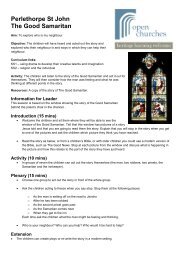The
Norwell, St Laurence - Southwell and Nottingham Church History ...
Norwell, St Laurence - Southwell and Nottingham Church History ...
You also want an ePaper? Increase the reach of your titles
YUMPU automatically turns print PDFs into web optimized ePapers that Google loves.
4 Earliest Stonework<strong>The</strong> westernmost pillar ofthe north aisle is differentfrom all the others. Itdates from the early 12thcentury; the irregularstonework is probably allthat remains of a smallrectangular church withnave and chancel. Noticehow the pillar is notsquare with the general lieof the aisle.3 Clock<strong>The</strong> clock dates frombefore 1850; it wasremoved fromNottingham GeneralHospital in 1947/8 andwas bought for Norwellchurch in 1953.2 Inscriptions on LeadBeneath the list ofincumbents on the northwall is a piece of lead,taken from the roofduring repairs in 1993.On it are various initialsand signatures, analphabet in capitals (spotthe characters the writerhad trouble with!), thedate, and the outline of ashoe.5 Carved heads<strong>The</strong> fine, carved timber-roof of the north transept is theonly part of the roof that dates from the 15th century.<strong>The</strong> southernmost boss is a green man (5a). Look outfor ‘Toothy’ at the junction with the north aisle (5b).Carved in stone and dating from around 1250 heclearly needed to visit the dentist! High on the southwall of the nave below the clerestory are three carvedheads; the centre one is the head of a muzzled bear(5c).1 South door<strong>The</strong> south doorway wasprobably moved to itspresent position whenthe south aisle wasadded; its solid roundpillars, with waterleafcapitals date it to 1200-25 when the walls of theearliest stone churchwould have beenpunched through.311 Font and Pulpit<strong>The</strong> church was restoredby the architect, EwanChristian in 1857 and1874. It is said that hecompleted the work inhis “spare time” while hewas employed atSouthwell Minster. <strong>The</strong>font, pulpit and reredoswere put in in 1876. <strong>The</strong>font was a gift from thevicar at that time, WilliamHutton, and his wife.421105b5c5a61111106 Rood stairs<strong>The</strong> stairs in the easternmostpillar of the northaisle led to the opening tothe rood screen, originallyseparating the chancelfrom the main body of thechurch. It was probablyremoved in the early 16thcentury.7 Choir stalls<strong>The</strong>se were built by HenryClipsham, a Norwellbuilder, in 1857-8. <strong>The</strong>cost was £34.78910 Effigies<strong>The</strong>re are two stoneeffigies. In the southtransept is the figure ofan armed, cross-leggedknight of c1330 with thehead detached from thebody. Traditionally thiseffigy has been identifiedwith Sir John de Lysours,Lord of Willoughby byNorwell, whose turbulentcareer was documenteduntil his murder in 1322.In the south aisle is theserene figure of a ladywith her hands placedtogether in prayer c1300-1350. <strong>The</strong> lady isunidentified but it is likelythat she belongs to thesame family for whomthe male figure wascarved.8 Reredos<strong>The</strong> three panels depict:a pelican feeding itsyoung, a cross, and alamb with a flag, withangels to left and right.9 GlassAll the existing stainedglass has been put insince the Victorianrestorations. <strong>The</strong> Eastwindow (1908), byCharles Kempe, wascompleted after his deathby his nephew, WalterTower. This is confirmedby the wheat sheaf(Kempe’s signature)containing a tower(Tower’s signature) in thebottom left sector of thewindow. <strong>The</strong> figuresdepicted include: StLaurence; St Mary;Christ; St John; and StHugh of Lincoln.<strong>The</strong> window in the northaisle is from 1903, alsoby Kempe. <strong>The</strong> pinnacledcity, also in the eastwindows is typical ofKempe windows.







